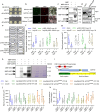Hydrogen peroxide is required for light-induced stomatal opening across different plant species
- PMID: 38876991
- PMCID: PMC11178795
- DOI: 10.1038/s41467-024-49377-9
Hydrogen peroxide is required for light-induced stomatal opening across different plant species
Abstract
Stomatal movement is vital for plants to exchange gases and adaption to terrestrial habitats, which is regulated by environmental and phytohormonal signals. Here, we demonstrate that hydrogen peroxide (H2O2) is required for light-induced stomatal opening. H2O2 accumulates specifically in guard cells even when plants are under unstressed conditions. Reducing H2O2 content through chemical treatments or genetic manipulations results in impaired stomatal opening in response to light. This phenomenon is observed across different plant species, including lycopodium, fern, and monocotyledonous wheat. Additionally, we show that H2O2 induces the nuclear localization of KIN10 protein, the catalytic subunit of plant energy sensor SnRK1. The nuclear-localized KIN10 interacts with and phosphorylates the bZIP transcription factor bZIP30, leading to the formation of a heterodimer between bZIP30 and BRASSINAZOLE-RESISTANT1 (BZR1), the master regulator of brassinosteroid signaling. This heterodimer complex activates the expression of amylase, which enables guard cell starch degradation and promotes stomatal opening. Overall, these findings suggest that H2O2 plays a critical role in light-induced stomatal opening across different plant species.
© 2024. The Author(s).
Conflict of interest statement
The authors declare no competing interests.
Figures






Similar articles
-
Brassinosteroid and Hydrogen Peroxide Interdependently Induce Stomatal Opening by Promoting Guard Cell Starch Degradation.Plant Cell. 2020 Apr;32(4):984-999. doi: 10.1105/tpc.19.00587. Epub 2020 Feb 12. Plant Cell. 2020. PMID: 32051210 Free PMC article.
-
UV RESISTANCE LOCUS8 mediates ultraviolet-B-induced stomatal closure in an ethylene-dependent manner.Plant Sci. 2020 Dec;301:110679. doi: 10.1016/j.plantsci.2020.110679. Epub 2020 Sep 18. Plant Sci. 2020. PMID: 33218642
-
KIN10 promotes stomatal development through stabilization of the SPEECHLESS transcription factor.Nat Commun. 2020 Aug 25;11(1):4214. doi: 10.1038/s41467-020-18048-w. Nat Commun. 2020. PMID: 32843632 Free PMC article.
-
Light-regulated stomatal aperture in Arabidopsis.Mol Plant. 2012 May;5(3):566-72. doi: 10.1093/mp/sss039. Epub 2012 Apr 19. Mol Plant. 2012. PMID: 22516479 Review.
-
Signaling Transduction of ABA, ROS, and Ca2+ in Plant Stomatal Closure in Response to Drought.Int J Mol Sci. 2022 Nov 26;23(23):14824. doi: 10.3390/ijms232314824. Int J Mol Sci. 2022. PMID: 36499153 Free PMC article. Review.
Cited by
-
Guard cell-specific glycine decarboxylase manipulation affects Arabidopsis photosynthesis, growth and stomatal behavior.New Phytol. 2025 Jun;246(5):2102-2117. doi: 10.1111/nph.70124. Epub 2025 Apr 11. New Phytol. 2025. PMID: 40219652 Free PMC article.
-
Guard cells on the adaxial and abaxial leaf surfaces use different compositions of potassium ion channels to drive light-induced stomatal opening.Nat Plants. 2025 Jul;11(7):1260-1269. doi: 10.1038/s41477-025-02026-5. Epub 2025 Jul 9. Nat Plants. 2025. PMID: 40634560 Free PMC article.
-
Stomata-targeted nanocarriers enhance plant defense against pathogen colonization.Nat Commun. 2025 May 23;16(1):4816. doi: 10.1038/s41467-025-60112-w. Nat Commun. 2025. PMID: 40410152 Free PMC article.
References
-
- Assmann SM, Simoncini L, Schroeder JI. Blue light activates electrogenic ion pumping in guard cell protoplasts of Vicia faba. Nature. 1985;318:285–287. doi: 10.1038/318285a0. - DOI
MeSH terms
Substances
Grants and funding
- ZR2022YQ20/Natural Science Foundation of Shandong Province (Shandong Provincial Natural Science Foundation)
- 2018ZX08005-01Bb/Natural Science Foundation of Shandong Province (Shandong Provincial Natural Science Foundation)
- 2018ZX08005-01B-004/Natural Science Foundation of Shandong Province (Shandong Provincial Natural Science Foundation)
- 32270351/National Natural Science Foundation of China (National Science Foundation of China)
- 32300927/National Natural Science Foundation of China (National Science Foundation of China)
- 32100236/National Natural Science Foundation of China (National Science Foundation of China)
- 31970306/National Natural Science Foundation of China (National Science Foundation of China)
- 32070210/National Natural Science Foundation of China (National Science Foundation of China)
- 32325006/National Natural Science Foundation of China (National Science Foundation of China)
- 2023M732077/China Postdoctoral Science Foundation
LinkOut - more resources
Full Text Sources

